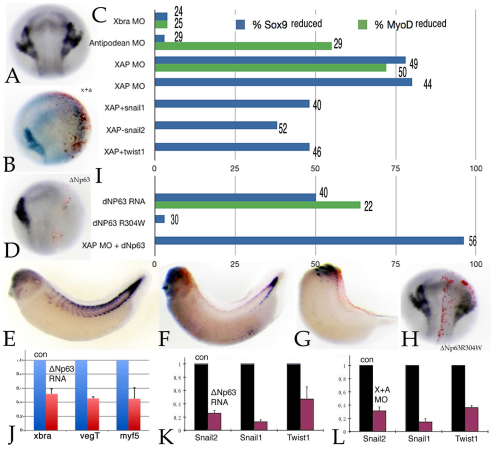Fig. 3.
Loss of mesoderm leads to loss of neural crest. (A,B) Injection of the xbra MO has little effect on myoD (stage 25) or sox9 (stage 17/18) expression. Injection of the antipodean/vegT MO causes a decrease in myoD expression (Fukuda et al., 2010), but little effect on sox9 expression (data not shown). Together (XAP), the xbra and antipodean/vegT MOs block sox9 (stage 17/18) (B, versus control in A) and myoD (data not shown) expression. (C) The percentage of embryos with loss of myoD or sox9 staining, with the number of embryos examined shown at the end of each bar. Injection of snail1, snail2 or twist1 RNAs (600 pg/embryo) produced a modest rescue of sox9 expression in XAP morphant embryos. (D-G) Injection of 600 pg ΔNp63 RNA into one cell of a 2-cell embryo led to the loss of sox9 (D), xbra (not shown) and myoD (F, moderate effect; G, severe effect; versus control in E) expression in ∼50% of embryos. (H) Injection of RNA encoding the mutated and inactive ΔNp63R304W protein had no effect on sox9 or myoD (data not shown) expression. (I) Quantitative presentation of the data shown in D-H. (J-L) qPCR analyses of ΔNp63 RNA-injected embryos (both cells of 2-cell embryos injected, analyzed at stage 11) revealed a substantial decrease in the levels of the xbra, vegT/antipodean and myf5 mesodermal marker RNAs (J). In both ΔNp63 RNA (K) and XAP MO (L) injected embryos, there were similar decreases in the levels of snail2, snail1 and twist1 RNAs. Error bars indicate s.d.

